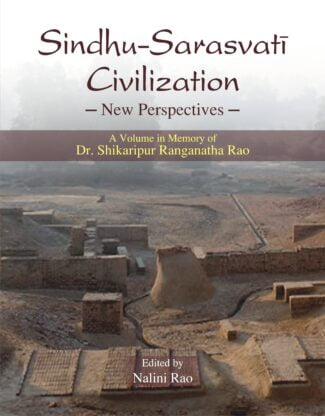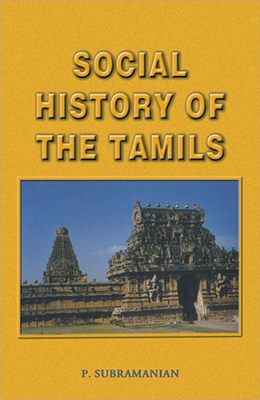Showing 161–170 of 184 results

This book seeks to level a new focus on archaeology and underscores the importance of using scientific knowledge and methods in its pursuit. It can be broadly segmented as the section on Science in Archaeological Studies and Science in Archaeo-material Studies.
Archaeology seeks to reconstruct the past by critically analysing various archaeo-remains such as artefacts, monuments, fossils etc. While much of what archaeology teaches, such as the postulates regarding the origin of the universe, social organisation in pre-historic times, the division of time periods etc., rightfully belong to the domain of conjecture, the ever-increasing use of tools derived from the various sciences in particular the material and digital sciences is rapidly justifying the description of archaeology as the most basic of sciences. This book, in which twenty-six authors have collaborated to present fifteen articles, seeks to level a new focus on archaeology and underscore the importance of using scientific knowledge and methods in its pursuit. This book can be broadly segmented as the section on Science in Archaeological Studies and Science in Archaeo- material Studies. To that end, the very first leading article in this monograph reviews the two cultures inherent in archaeology and strongly endorses the scientific aspect. The recent contributions of modern science towards archaeological research have been reviewed in this article and strongly recommended to the young learners and researchers for emulation. Thereafter, methods as diverse as radio-carbon dating; remote sensing in archaeological surveys aided by micro-electronics; genetic perspective of the Indian population; analysis of archaeological residues and slag, Indian pottery and archaeo-metals; use of non-destructive testing methodo-logies etc., are discussed in detail. These articles will serve as pointers for future generations of archaeologists in their quest for more exhaustive and verifiable knowledge.

The world famous Amaravati sculptures and art pieces take the pride of place in India’s best museums today. This volume lists and analyses with photo illustrations the large museum antiquities typologically and chronologically. The book will interest historians, archaeologists and general readers.
The Amaravati sculptures are famous throughout the world for their special features and they form a distinct school of art called Amaravati school of art. Though Amaravati art pieces take the pride of place in Indias best museums, the sculptures in the site museum at Amaravati itself have not been assigned enough significance. This volume lists and analyses the museum antiquities typologically and chronologically. The effort includes all the museum antiquities, including many objects of seemingly minor importance, which are described in detail. Their types and features, provenance, probable period, measurements and accession number, references to them and details of inscriptions relating to them are provided. The catalogue of objects features twenty main headings including the pillars, slabs, pilasters, beads, ceramics and copper plate grants. There are photo illustrations of a large number of antiquities that form the museum collection which have enormous archaeological, epigraphic and iconographic merit. The book will interest historians, archaeologists and general readers keen on knowing about Indian culture and art.

How many of us know about the persons involved in pulling down the controversial structure the Babari Masjid in Ayodhaya? What is the importance of Ram janmabhoomi? Was the Babari structure built on the portions of Ram Mandir? All this and much more in a QuestionAnswer form, based on ground realities, presented in this book.
How many of us know about the persons involved in pulling down the controversial structure the Babari Masjid in Ayodhaya? What is the importance of Ram janmabhoomi? Was the Babari structure built on the portions of Ram Mandir? All this and much more in a QuestionAnswer form, based on ground realities, presented in this book.

In this book eminent archaeologists, philologists, anthropologists and historians re-examine recent research and existing theories upon the nature of the interrelation between the two most ancient prehistoric cultures of the South Asian subcontinent: the Indus (Sindhu) or Harappan Civilization and the Vedic Civilization.
SindhuSarasvati Civilization: New Perspectives. A Volume in Memory of Dr Shikaripur Ranganatha Rao is a compilation of the papers presented at the International Conference on the SindhuSarasvati Civilization: A Reappraisal held in Loyola Marymount University, Los Angeles, during 21-22 February 2009. Here, eminent archaeologists, philologists, anthropologists and historians re-examine recent researches and existing theories upon the nature of the interrelation between the two most ancient prehistoric cultures of the South Asian subcontinent: the Indus (Sindhu or Harappan Civilization) and the Vedic Civilization. The scholars touch upon areas of consensus and contentions, with a tentatively conclusive interdisciplinary understanding about the pluralistic culture and shared identity of the two riverine cultures between 3000 and 1500 bce.
They rightly swing the balance of the argument away from the archaic and now exploded Aryan Invasion Theory to the well-grounded Vedic Sarasvati milieu as the home of the Harappan Civilization. Thus it opens a new window to the cultural content of the prehistoric period of the subcontinent.
The eminent personalities that have contributed include Ashok Aklujkar, Shiva G. Bajpai, Giacomo Benedetti, R.S. Bisht, Edwin Bryant, Michel Danino, Subhash Kak, Robin Bradley Kar, Nicholas Kazanas, Mark Jonathan Kenoyer, Prem Kishore Saint, Jim J. Shaffer, Diane A. Lichtenstein, Shrikant Talageri, Lavanya Vamsani as well as Sundara Adiga, S.R. Rao, and Nalini Rao.
This volume is poised to evoke keen interest among archaeologists, researchers, historians and students of history and archaeology.

The book offers an account of the Tamils society, economy, religious beliefs, educational mechanisms, arts and cultural expressions (during 1707-1947). It also discusses the profound influence of colonial rule in the tradition-bound Tamilian society.
Notwithstanding the prolificity of indepth researches in contemporary historiography, Professor Subramanian’s book is the first concentrative effort to track down the social history of the Tamils. Today, the Tamils, over fifty million of them, live in the south-eastern state of the Indian peninsula: Tamil Nadu — which indisputably represents the very nucleus of millennia-old Dravidian culture in India. The book offers a compelling account of the Tamils’ society, economy, religious beliefs, educational mechanisms, arts, and cultural expressions during the years 1707-1947 — when, significantly, the British domination blossomed, bloomed, and faded; when new thoughts, new ideas, and new ways of life came as irresistibly into the homeland of the Tamils as into the Indian subcontinent. Thus retracing over two centuries of the ‘British connextion with India’, the author here tries to show how the long colonial rule in India exposed the tradition-bound Tamilian society to Western influences — with results that proved incalculable in both their range and depth. Social History of the Tamils : 1707-1947 is the outcome of Professor Subramanian’s decade-long, painstaking research, authenticated by an astonishing mass of evidence including archival records, Jesuit sources, Modi (Maratha) manuscripts, newspapers’ reports, biographies, travelogues, literary writings, and even fictional works.

The book unveils the ancient Indian society in all its variegated evolutionary expressions across 2500 years to explore the sociological orientations of the Vedic Samhitas, Brahmanas, Upanisads and other Sanskrit works besides Buddhist and Jaina works.
It is a fascinating, meticulously documented study unveiling, for the first time, the ancient Indian society in all its variegated evolutionary expressions across about two-and-a-half millennia: since the Vedic times (c. 1500 BC) with a beautifully well-knit account of its religions and cultic practices; economic paradigms; polity and statecraft; educational set-up; customes, manners, etiquettes; food habits, drinks, dress styles; sports, pastimes, modes of recreations; sex life and sexual morality; casteist hierarchies; attitude towards women; and its crimes, punishments and legal codes. Epitomising a lifetime of Dr. Banerjis research on ancient India, the book vividly captures all different articulations of sociological import from a whole body of traditional writings: both sacred and secular. Again, it turns out to be the first ever study to singly explore the sociological orientations of the Vedic Samhitas, Brahmanas, Upanishads, Kalpasutras, Vyakaranas, Puranas, Smritishastras, Tantric texts, the Ramayana, the Mahabharata, Kautilyas Arthashastra, and many other Sanskrit classics besides Buddhist and Jaina works in Pali, Prakrit and Apabhramsha languages. With highly informative appendices, extensive bibliographic references and a glossary of technical/unfamiliar words, the book holds out enduring appeal to both scholars and discerning readers.
The Socio-Literary and Cultural Study of Indian Society from Ancient to Modern is a search for India’s heritage: Hindu, Sufi and about Nationalism and India’s freedom from her colonial past. It is analytical but not learnedness. The author believes as Iqbal, the famous Urdu poet, said: “Transcend your reason because though it is a glow, it is not your destination; it can only be the path to the destination show.” People, both Indian and foreign, who want to understand Indian heritage from Ancient to Modern in a simple, agreeable style and friendly manner, is the author’s destination. In this volume, he has tried to demolish many myths like dharma is religion, Vedas are Śruti though the Almighty ordered six ṛṣis to write them down. A Hindu is just not emotional in mind, he also believes in analytic discussion (tarka). Upaniṣads are not just created by ṛṣis but also by a revolution unfolded by the students by barraging questions after questions.By explaining about the vitality of India and many other subjects, the book elucidates many things about the idea of India in an authentic manner. The readers will find here many varieties of theological explication, ultimately leading to the celebration of life while searching for the divine and realizing the self.

The volume examines the triangular relationship and conflicts among the Indian princes, the politicians and the British over the channels of communication, interference in administration, succession to throne and the collection of import duties. The book also explores the honours system of titles and salutes, which played a central role in princely India.
In Sovereignty, Power, Control, John McLeod uses the princely states of the Western India States Agency (now in Gujarat) as a case-study to examine the triangular relationship among the Indian princes, the politicians of the states’ people’s movements, and the British. He argues that the princes were motivated by the desire to safeguard their sovereignty; the politicians by a quest for a share in power in the states; and the British by a policy of maintaining control. McLeod first analyses the conflict among the parties over the channels of communication between the princes and the British, the collection of duty on imports at state ports, and the existence of numerous small states in Gujarat. He then turns to British interference in the princes’ affairs over the issues of minority administration, maladministration, and succession to princely thrones. Finally, he explores the honours system of titles and salutes, which played a central role in princely India.
| There are no products |